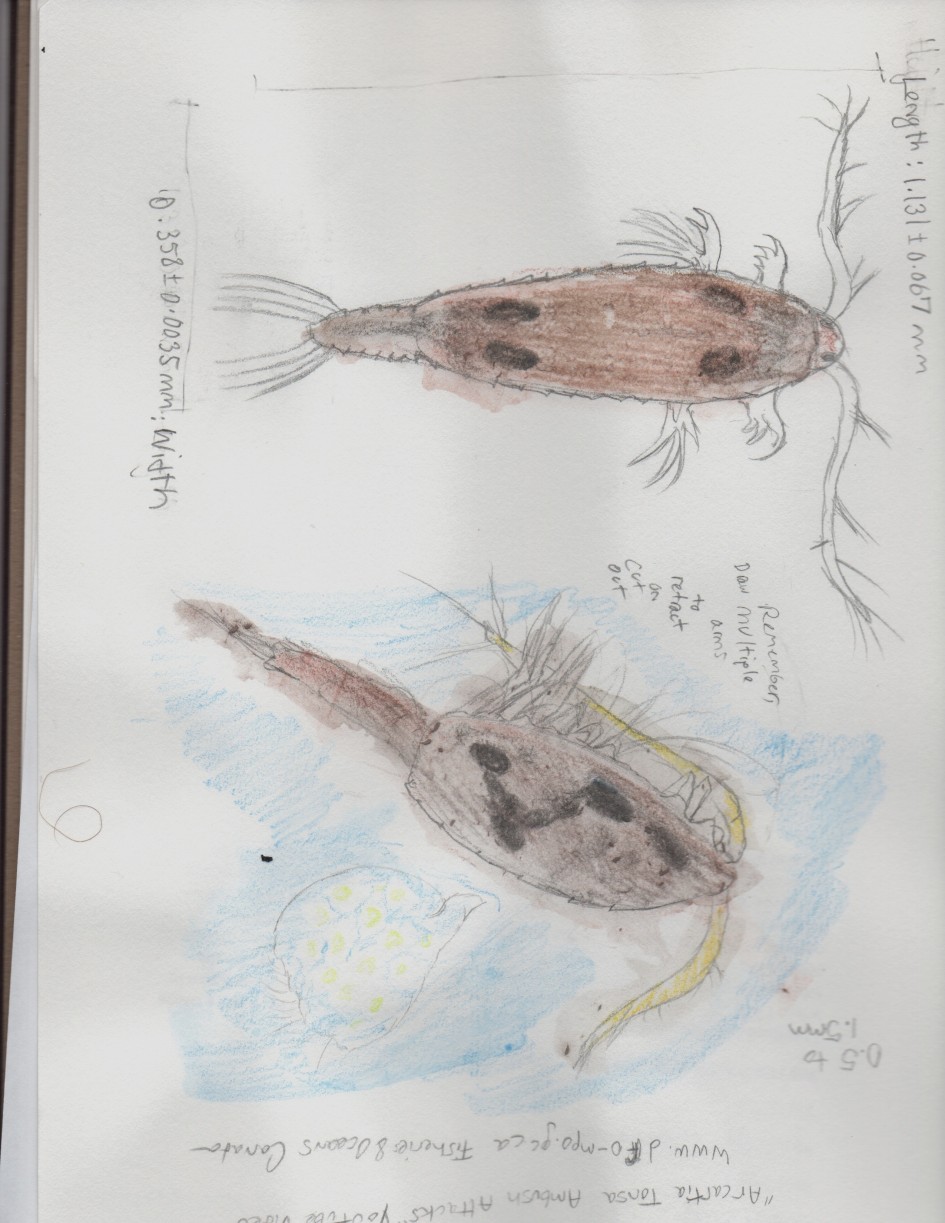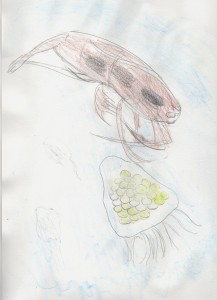Acartia tonsa
by DWL
(Fisheries and Oceans, 2009; sanpm95, 2010; Scripps Institution of Oceanography, Accessed November 2015.)
(sanpm95, 2010)
General and Ecological Information
Scale: 0.5 to 1.5mm (Gonzalez, 2013).
Acartia tonsa are planktonic organisms that live in estuaries and coastal areas (Gonzalez, 2013). They are related to crustaceans (Gonzalez, 2013). They use maxillipeds (appendages exclusive to crustaceans) in order to feed (Gonzalez, 2013). A. tonsa feeds on Rotifers and Ciliates, diatoms (Gonzalez, 2013).
A. tonsa has two different methods of catching motile and immotile prey. When they feed on motile prey, A. tonsa sink down to a certain water level without moving any appendage (Kiørboe et al. 1996). They sense the prey (Ex: Ciliate) via Mechanoreceptor on the antennae (Kiørboe et al. 1996). They jump to a great distance and angle quickly to catch and digest their prey (Kiørboe et al. 1996). They catch immotile prey by generating a feeding current in order to filter out the immotile prey during respiration (Kiørboe et al. 1996). A. tonsa have a 3 to 4 week maturation period (Kiørboe et al. 1985).
Scientific Studies
One scientific Study on A. tonsa (Kiørboe et al. 1996) was about observing the method in which they attacked their prey (Kiørboe et al. 1996). They hypothesized that the A. tonsa has 2 different methods of capturing motile (ciliates) and immotile prey (diatoms) (Kiørboe et al. 1996). They also hypothesized that turbulence would change as different methods would be used (Kiørboe et al. 1996).
The experiment was done 14 times (Kiørboe et al. 1996). Each experiment was done with a concentration of ciliates (Strombidium), diatoms (Thalassiosira weissflogu) and or copepods (Kiørboe et al. 1996). They had 4 replicate experiment and 4 controlled experiments without the copepods (Kiørboe et al. 1996). They also observed the diatoms using 12 different combinations in bottles (Kiørboe et al. 1996). Turbulence was simultaneously tested in the bottles (Kiørboe et al. 1996).
The results were that when the A. tonsa ate ciliates, it would eat less diatoms (Kiørboe et al. 1996). However, their hypothesis that the A. tonsa was too busy to eat ciliates when they were eating diatoms was proven false (Kiørboe et al. 1996). The results also did confirm that there was a switching of methods when catching motile and/or immotile prey (Kiørboe et al. 1996). Finally, the results did confirm a difference in turbulence with the different methods of catching prey (Kiørboe et al. 1996).
Another study about A. Tonsa by Kiorboe featured measuring the A. tonsa’s rate of clearance, ingestion, ammonia excretion, respiration and egg production compared to its food concentration (Kiørboe et al. 1985). They had thought that the A. tonsa’s metabolic feeding rate was due to its growth and transport (Kiørboe et al., 1985).
For the experiment, A. tonsa were held in tanks and were given plankton algae, Isochrysis galbana and Rhodomonas to feed off of (Kiørboe et al. 1985). The scientists studied the A. tonsa’s rate of ingestion by incubating 10 to 15 females in glass jars (Kiørboe et al. 1985). They were then placed in 4 bottles with Rhodomonas (Kiørboe et al. 1985). There were also 2 bottles without A. tonsa (Kiørboe et al. 1985). To measure respiration rate, the scientists placed 20 fertilized female A. tonsas in a respiration chamber, which is a glass tube connected to silicone stoppers (Kiørboe et al. 1985). A needle would be occasionally inserted to give food and water to the A. tonsas (Kiørboe et al. 1985). The oxygen rate inside the chamber was monitored. Finally, in order to test the ammonia excretion, the A. tonsas were washed by filtered water to be put in beakers (Kiørboe et al. 1985). The scientists would take one sample from the beaker to measure the ammonia excretion (Kiørboe et al. 1985).
The results showed that A. Tonsa’s egg production declined when given a consistently high amount of food (Kiørboe et al. 1985). The A. tonsa’s egg production grew when there was a gradient of low to high food concentration (Kiørboe et al. 1985). The rate of respiration was constant for 8 hours (around an 8 out of 10) (Kiørboe et al. 1985). Then afterwards, the respiration rate decreased (to a 2) dramatically (Kiørboe et al. 1985). After day 2, the respiration rate was at a constant number below 2 (Kiørboe et al. 1985). They found that lipids are not vital to the survival of the A. tonsa (Kiørboe et al. 1985).
Symbolism for Humanity
The A. tonsa seems to be a very selective organism. The A. tonsa will execute a method of catching prey that will make the most sense for them. For example, they will become still in order to jump and catch motile prey. They also create a current to catch sessile prey. Both of these methods require a large amount of energy. The A. Tonsa needs to be selective in how much energy it will use and when. That is why the A. tonsa deliberately makes decisions that will benefit it. This can be applied to people making decisions on what to do with their time. Will they go do work or will they rest? The A. tonsa is similar to a person who is an expert in time management as it makes the choice that makes the most sense for them in the situation.
References
- Gonzalez, G. 2013. “Acartia tonsa”, Animal Diversity Web. Web. Accessed November 2015.
- Kiørboe, Thomas, Møhlenberg, Flemming, Hamburger, Kirsten (1985). Bioenergetics of the planktonic copepod Acartia tonsa: relation between feeding, egg production and respiration, and composition of specific dynamic action. Marine Ecology. Vol. 26: pgs. 85-97.
- Kiørboe, Thomas, Saiz, Enric, Viitasalo, Markku (1996). Prey Switching Behaviour in the planktonic copepod Acartia tonsa. Marine Ecology. Vol. 143: 65-75.
- Fisheries & Oceans Canada. 2009. “Untitled Acartia tonsa Image”, Web. Accessed November 2015.
- Sanpm95. 2010. “Acartia Ambush Attacks”, Youtube. Accessed November 2015.
- Scripps Institution of Oceanography. “Untitled Acartia tonsa Image”, Web. Accessed November 2015.






